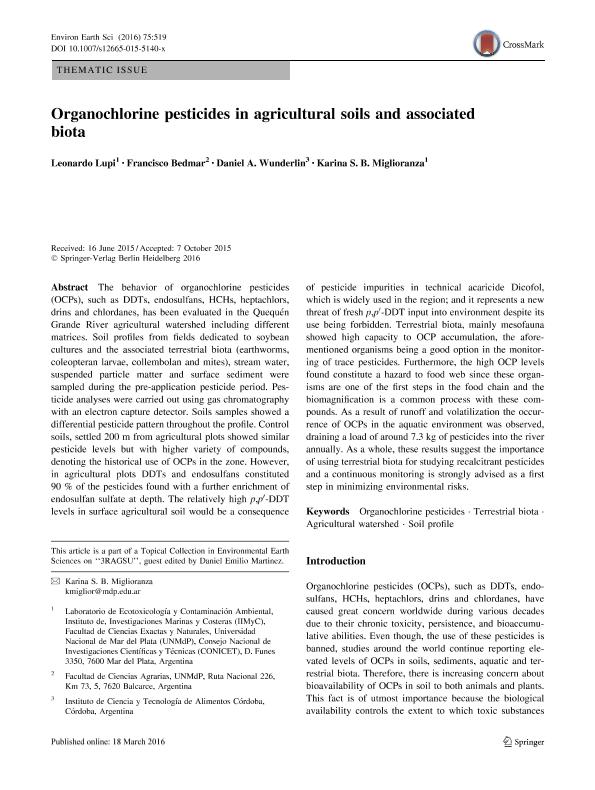Artículo
Organochlorine pesticides in agricultural soils and associated biota
Fecha de publicación:
03/2016
Editorial:
Springer Verlag
Revista:
Environmental Earth Sciences
ISSN:
1866-6280
e-ISSN:
1866-6299
Idioma:
Inglés
Tipo de recurso:
Artículo publicado
Clasificación temática:
Resumen
The behavior of organochlorine pesticides (OCPs), such as DDTs, endosulfans, HCHs, heptachlors, drins and chlordanes, has been evaluated in the Quequén Grande River agricultural watershed including different matrices. Soil profiles from fields dedicated to soybean cultures and the associated terrestrial biota (earthworms, coleopteran larvae, collembolan and mites), stream water, suspended particle matter and surface sediment were sampled during the pre-application pesticide period. Pesticide analyses were carried out using gas chromatography with an electron capture detector. Soils samples showed a differential pesticide pattern throughout the profile. Control soils, settled 200 m from agricultural plots showed similar pesticide levels but with higher variety of compounds, denoting the historical use of OCPs in the zone. However, in agricultural plots DDTs and endosulfans constituted 90 % of the pesticides found with a further enrichment of endosulfan sulfate at depth. The relatively high p,p′-DDT levels in surface agricultural soil would be a consequence of pesticide impurities in technical acaricide Dicofol, which is widely used in the region; and it represents a new threat of fresh p,p′-DDT input into environment despite its use being forbidden. Terrestrial biota, mainly mesofauna showed high capacity to OCP accumulation, the aforementioned organisms being a good option in the monitoring of trace pesticides. Furthermore, the high OCP levels found constitute a hazard to food web since these organisms are one of the first steps in the food chain and the biomagnification is a common process with these compounds. As a result of runoff and volatilization the occurrence of OCPs in the aquatic environment was observed, draining a load of around 7.3 kg of pesticides into the river annually. As a whole, these results suggest the importance of using terrestrial biota for studying recalcitrant pesticides and a continuous monitoring is strongly advised as a first step in minimizing environmental risks.
Archivos asociados
Licencia
Identificadores
Colecciones
Articulos(ICYTAC)
Articulos de INST. DE CIENCIA Y TECNOLOGIA DE ALIMENTOS CORDOBA
Articulos de INST. DE CIENCIA Y TECNOLOGIA DE ALIMENTOS CORDOBA
Citación
Lupi, Leonardo; Bedmar, Francisco; Wunderlin, Daniel Alberto; Miglioranza, Karina Silvia Beatriz; Organochlorine pesticides in agricultural soils and associated biota; Springer Verlag; Environmental Earth Sciences; 75; 6; 3-2016
Compartir
Altmétricas




